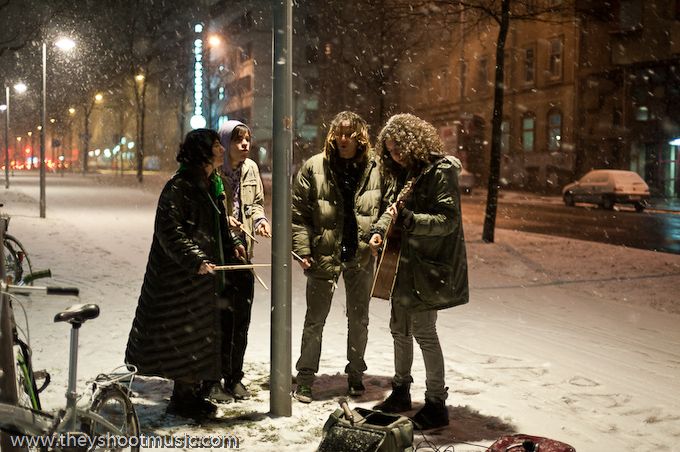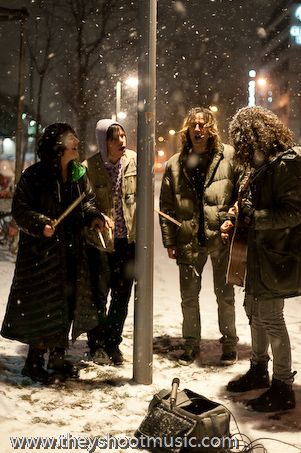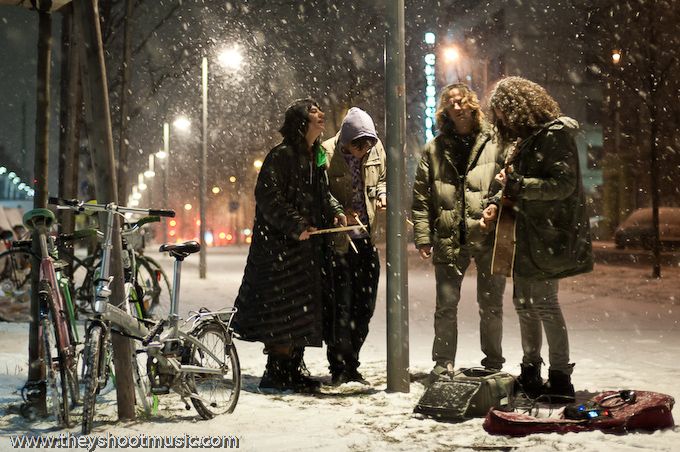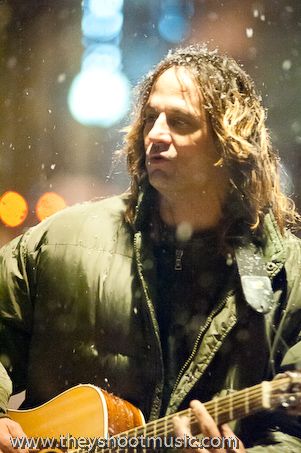Japanther and Shellshag
B72, Gürtel, 2011
When we first got in touch with the Brooklyn-based Japanther, drummer and singer Ian Vanek was responsible for the strangest e-mail-communication in the history of this video blog. We asked, if they wanted to play for us. “If we can sing to a golden fountain, yes.” We asked, if a bronze one would be okay too (it’s surprisingly hard to find golden fountains in Vienna…). “No, it won’t due. Must be the golden fountain.” We asked, how they are planning to play the session. “Acappella with running water late at night.” However, the reality turned out to be slightly different: not running water, but falling snow under a yellow…uhm golden street lamp! And most importantly Japanther were now supported by Shellshag (the duo is from Brooklyn as well) for animated covers of “Stars and Bars” from Kung Fu USA and “Yesterday” from Shotwell. Who would have thought, that these messy, punky noise rock bands would really go acoustic!
- Photography
- Matthias Hombauer
- Artist
- Japanther and Shellshag










B72
Small but mighty. Countless petite-scheduled acts with big potentials have played the intimate setting of B72 since its start in 1998. Some of them – like Calexico or Tocotronic – have grown huge since their early performance at B72, some of them played here even though they are popular enough to fill larger venues – Zoot Woman, Bodi Bill or Malajube – and then there is the rest of bands that is meant to operate on small-scale till the end of their days. It is the mixture of pastime on one evening and exciting discoveries on another that makes you study the B72 programme. While the weekend crowd, that is partying to “Going Underground” or “Alternative Saturday Night”, is homogenously young, there is enough diversity during the rest of the week. Located in the eponymous railway arches 72-73 at Hernalser Gürtel and opened daily from 8 p.m. to 4 a.m., B72 moreover belongs to the good pop-in-for-a-beer-places along this busy road.
Gürtel
Two circular roads around the city center provide a basic way of orientation in Vienna. The one, Ringstraße is popular and touristy, whereas the other, Gürtel (meaning belt), is dominated by heavy traffic and separates the so-called inner districts (3rd to 9th district) from the outer districts and former suburbs of Vienna (10th to 19th district). Gürtel is the colloquial name for what is officially called Wiener Gürtelstraße or B221, Austria’s most frequented state road. On its length of 13.1 kilometres, six-to-eight-lane Gürtel road encircles central Vienna on the north, west and south, passing the two main train stations Westbahnhof and Südbahnhof. Similar to the Ringstraße, the course of today’s Gürtel was used as a fortification from the 17th to the 19th century. In the 1890s the famous Art Nouveau architect Otto Wagner designed a city railway along the Gürtel, that runs partly on a viaduct and is now the trace of the underground line U6. Until the end of World War II the Gürtel was a popular residential area with short connections to the city center but also the green and spacious outskirts close-by. The picture drastically changed with the population getting motorized. Quality of life dropped as traffic exploded and the western part of the Gürtel developed into a red-light district. Besides, in an attempt to revive the area, an urban regeneration project was started in the 1990s. The Main Public Library now upgrades Urban-Loritz-Platz and numerous restaurants, pubs and music clubs like Chelsea, rhiz and B72 opened along the Lerchenfelder Gürtel in the arches of the railway viaduct, making the area – at least in the evening – well worth a visit.’